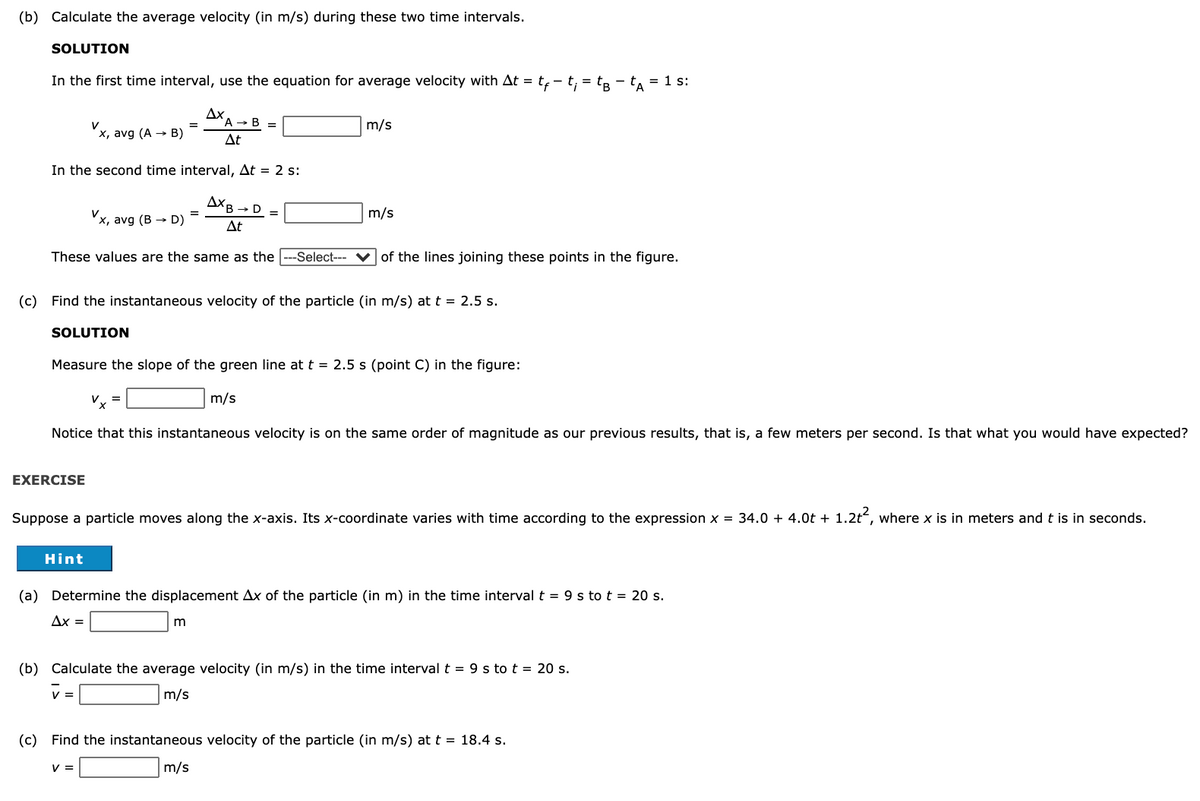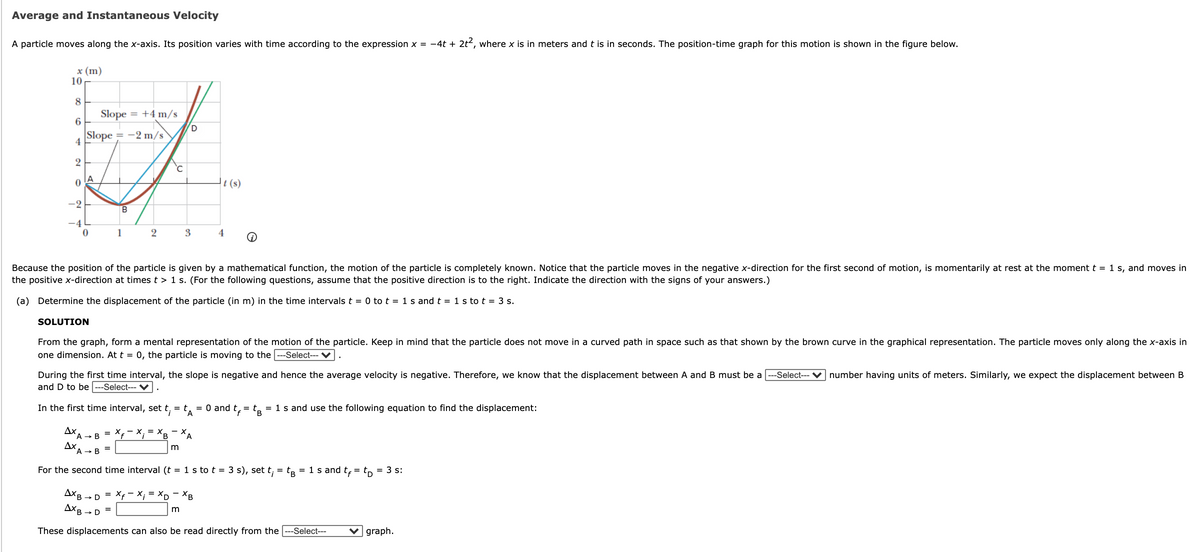SOLUTION In the first time interval, use the equation for average velocity with At = t, - t, = te - ta = 1 s: Дх, = x, avg (A - B) A -B = m/s At In the second time interval, At = 2 s: AXB -D = Vx, avg (B - D) m/s At These values are the same as the --Select-- V of the lines joining these points in the figure. (c) Find the instantaneous velocity of the particle (in m/s) at t = 2.5 s. SOLUTION Measure the slope of the green line at t = 2.5 s (point C) in the figure: Vy = m/s Notice that this instantaneous velocity is on the same order of magnitude as our previous results, that is, a few meters per second. Is that what you would have expected? EXERCISE Suppose a particle moves along the x-axis. Its x-coordinate varies with time according to the expression x = 34.0 + 4.0t + 1.2t, where x is in meters and t is in seconds. Hint (a) Determine the displacement Ax of the particle (in m) in the time interval t = 9 s to t = 20 s. Ax = m (b) Calculate the average velocity (in m/s) in the time interval t = 9 s to t = 20 s. m/s (c) Find the instantaneous velocity of the particle (in m/s) att = 18.4 s. V = m/s
SOLUTION In the first time interval, use the equation for average velocity with At = t, - t, = te - ta = 1 s: Дх, = x, avg (A - B) A -B = m/s At In the second time interval, At = 2 s: AXB -D = Vx, avg (B - D) m/s At These values are the same as the --Select-- V of the lines joining these points in the figure. (c) Find the instantaneous velocity of the particle (in m/s) at t = 2.5 s. SOLUTION Measure the slope of the green line at t = 2.5 s (point C) in the figure: Vy = m/s Notice that this instantaneous velocity is on the same order of magnitude as our previous results, that is, a few meters per second. Is that what you would have expected? EXERCISE Suppose a particle moves along the x-axis. Its x-coordinate varies with time according to the expression x = 34.0 + 4.0t + 1.2t, where x is in meters and t is in seconds. Hint (a) Determine the displacement Ax of the particle (in m) in the time interval t = 9 s to t = 20 s. Ax = m (b) Calculate the average velocity (in m/s) in the time interval t = 9 s to t = 20 s. m/s (c) Find the instantaneous velocity of the particle (in m/s) att = 18.4 s. V = m/s
College Physics
1st Edition
ISBN:9781938168000
Author:Paul Peter Urone, Roger Hinrichs
Publisher:Paul Peter Urone, Roger Hinrichs
Chapter2: Kinematics
Section: Chapter Questions
Problem 30CQ: Consider the velocity vs. time graph of a person in an elevator shown in Figure 2.58. Suppose the...
Related questions
Question

Transcribed Image Text:(b) Calculate the average velocity (in m/s) during these two time intervals.
SOLUTION
In the first time interval, use the equation for average velocity with At = t, - t; = tp - t, = 1 s:
Дх
A - B =
V
x, avg (A → B)
m/s
At
In the second time interval, At = 2 s:
AXB - D
х, avg (В - D)
m/s
At
These values are the same as the ---Select---
of the lines joining these points in the figure.
(c) Find the instantaneous velocity of the particle (in m/s) at t = 2.5 s.
SOLUTION
Measure the slope of the green line at t = 2.5 s (point C) in the figure:
m/s
Notice that this instantaneous velocity is on the same order of magnitude as our previous results, that is, a few meters per second. Is that what you would have expected?
EXERCISE
Suppose a particle moves along the x-axis. Its x-coordinate varies with time according to the expression x = 34.0 + 4.0t + 1.2t“, where x is in meters and t is in seconds.
Hint
(a) Determine the displacement Ax of the particle (in m) in the time interval t = 9 s to t = 20 s.
Ax =
m
(b) Calculate the average velocity (in m/s) in the time interval t = 9 s to t = 20 s.
m/s
(c) Find the instantaneous velocity of the particle (in m/s) at t = 18.4 s.
V =
m/s

Transcribed Image Text:Average and Instantaneous Velocity
A particle moves along the x-axis. Its position varies with time according to the expression x = -4t + 2t2, where x is in meters and t is in seconds. The position-time graph for this motion is shown in the figure below.
x (m)
10
8.
Slope
6.
= +4 m/s
Slope
= -2 m/s
4
A
t (s)
-2
B.
-4
1
3
4
Because the position of the particle is given by a mathematical function, the motion of the particle is completely known. Notice that the particle moves in the negative x-direction for the first second of motion, is momentarily at rest at the moment t = 1 s, and moves in
the positive x-direction at times t > 1 s. (For the following questions, assume that the positive direction is to the right. Indicate the direction with the signs of your answers.)
(a) Determine the displacement of the particle (in m) in the time intervals t = 0 to t = 1 s and t = 1 s to t = 3 s.
SOLUTION
From the graph, form a mental representation of the motion of the particle. Keep in mind that the particle does not move in a curved path in space such as that shown by the brown curve in the graphical representation. The particle moves only along the x-axis in
one dimension. At t = 0, the particle is moving to the ---Select--- V
During the first time interval, the slope is negative and hence the average velocity is negative. Therefore, we know that the displacement between A and B must be a
and D to be ---Select--- V
-Select--- V number having units of meters. Similarly, we expect the displacement between B
In the first time interval, set t
= t, = 0 and
A
= t, = 1s and use the following equation to find the displacement:
AXA - B
= X- X
XB
A
AXA - B
m
=
For the second time interval (t = 1 s tot = 3 s), set t, = tp = 1 s and t, = tp = 3 s:
AxB
AxB - D
Xf - X; = XD – XB
=
These displacements can also be read directly from the
-Select---
V graph.
Expert Solution
This question has been solved!
Explore an expertly crafted, step-by-step solution for a thorough understanding of key concepts.
This is a popular solution!
Trending now
This is a popular solution!
Step by step
Solved in 2 steps with 2 images

Recommended textbooks for you

College Physics
Physics
ISBN:
9781938168000
Author:
Paul Peter Urone, Roger Hinrichs
Publisher:
OpenStax College

College Physics
Physics
ISBN:
9781305952300
Author:
Raymond A. Serway, Chris Vuille
Publisher:
Cengage Learning

College Physics
Physics
ISBN:
9781285737027
Author:
Raymond A. Serway, Chris Vuille
Publisher:
Cengage Learning

College Physics
Physics
ISBN:
9781938168000
Author:
Paul Peter Urone, Roger Hinrichs
Publisher:
OpenStax College

College Physics
Physics
ISBN:
9781305952300
Author:
Raymond A. Serway, Chris Vuille
Publisher:
Cengage Learning

College Physics
Physics
ISBN:
9781285737027
Author:
Raymond A. Serway, Chris Vuille
Publisher:
Cengage Learning

Physics for Scientists and Engineers: Foundations…
Physics
ISBN:
9781133939146
Author:
Katz, Debora M.
Publisher:
Cengage Learning

Physics for Scientists and Engineers, Technology …
Physics
ISBN:
9781305116399
Author:
Raymond A. Serway, John W. Jewett
Publisher:
Cengage Learning

Glencoe Physics: Principles and Problems, Student…
Physics
ISBN:
9780078807213
Author:
Paul W. Zitzewitz
Publisher:
Glencoe/McGraw-Hill